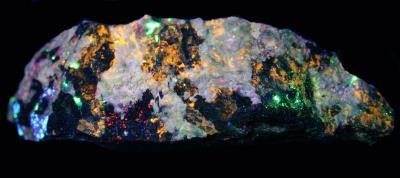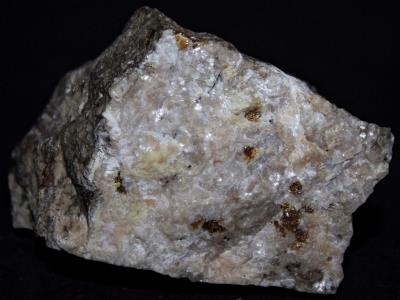 | |  |
Prehnite, willemite, axinite, margarosanite, xonotlite, includes non-fluorescent andradite garnet and hendricksite mica, from Franklin, New Jersey. From the collection of, and photo by JVF.
| | Prehnite, willemite, axinite, margarosanite, xonotlite, includes non-fluorescent andradite garnet and hendricksite mica, from Franklin, New Jersey, under shortwave UV light. The prehnite fluoresces yellow-orange, willemite green, axinite red, margarosanite blue and the xonotlite purple. From the collection of, and photo by JVF. |
|
 | |  |
Prehnite, xonotlite, pectolite, clinohedrite, axinite-(Mn), calcite, willemite and andradite garnet from Franklin, NJ. 2" X 1 3/8". From the collection of Alex & Gary Kerstanski, photo by Alex Kerstanski.
| | Prehnite, xonotlite, pectolite, clinohedrite, axinite-(Mn), calcite, willemite and andradite garnet from Franklin, NJ under shortwave UV light. The prehnite fluoresces lavender purple, xonotlite purple-blue, pectolite orange, clinohedrite brighter orange, and the calcite red-orange, axinite-(Mn) deep red, calcite red-orange and the willemite green, the andradite is non-fluorescent. 2" X 1 3/8". From the collection of Alex & Gary Kerstanski, photo by Alex Kerstanski. |
|
